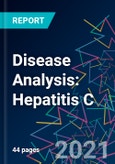Latest Key Takeaways
- The publisher estimates that in 2018, there were 72.2 million prevalent cases of hepatitis C worldwide.
- Therapeutic strategies for chronic hepatitis C have evolved rapidly over recent years. Following the debut of Sovaldi in 2013, direct-acting antiviral (DAA) combination regimens containing at least two modes of action (nucleotide NS5B inhibitors, NS5A inhibitors, and NS3/4A protease inhibitors) have rapidly become the standard of care, replacing older interferon-based regimens. The drastic shift to DAA regimens is due to their significant advances in cure rates (≥95%), greatly improved tolerability profiles, and shortened treatment durations (down from 48 weeks to 8-12 weeks for most patients).
- Since peaking in 2015, the sales value of the hepatitis C market has entered a protracted decline as intensifying competition has slashed treatment costs, and patient numbers have fallen sharply in the US, Japan, and five major European markets (France, Germany, Italy, Spain, and the UK). Despite significant improvements in patient access to treatment as payers have lifted treatment restrictions in response to lower treatment costs, the patient pool is expected to continue to shrink as the influx of newly diagnosed patients fails to offset the high number of patients exiting the treatment algorithm due to cure. Thus, investment in initiatives to improve screening uptake and linkage to care will be critical in softening the pace of this decline.
- The COVID-19 pandemic led to a steep, transient decline in market value in 2020 (sales of $4,061m versus $6,202m in 2019) as new patient initiations dropped due to disrupted screening initiatives and difficulty in accessing physician care, particularly in patients with less advanced fibrosis where treatment can be delayed without risking negative outcomes. Sales are expected to partially recover in 2021, but will fall in a stepwise fashion thereafter due to gradual exhaustion of the pool of diagnosed patients available for treatment.
- The launch of AbbVie’s Mavyret in 2017 shook up the hepatitis C market and led to AbbVie severely eroding the market share of Gilead, which had previously dominated the field with rival regimens Harvoni (mainly GT-1) and Epclusa (all genotypes). Both Mavyret and Epclusa possess pan-genotypic activity, which positions them as one-size-fits-all regimens and provides a strategic advantage in payer negotiations versus Merck & Co’s Zepatier, which is only efficacious in GT-1/4 patients. However, Mavyret possesses the advantage of a shorter eight-week duration in most treatment-naïve patients versus Epclusa’s 12-week dosing, and AbbVie also priced Mavyret at an aggressive discount to Epclusa to rapidly capture market share. The publisher believes that market dynamics in the hepatitis C space will remain relatively stable, with Mavyret expected to continue to command the majority of market share and Epclusa continuing to hold out in second place.
- Harvoni and Zepatier’s commercial prospects will continue to suffer from their limited genotypic potency (GT-1/4) and competition from pan-genotypic regimens. Indeed, Harvoni’s global sales declined from $4,370m in 2017 to just $272m in 2020 due to a combination of competition from Mavyret and cannibalization of its patient share from Gilead’s own Epclusa (as well as the impact of the COVID-19 pandemic), while Zepatier’s 2020 global sales totaled just $167m, down from a peak of $1,660m in 2017. This trend is expected to continue now that simplified US and European treatment guidelines promote the use of pan-genotypic regimens.
- Gilead’s Vosevi has addressed the final clinical unmet need for an effective treatment option in the small minority of patients who fail treatment with first-line DAA regimens. Such patients commonly develop resistance-associated substitutions (RASs), particularly to NS5A inhibitors, which render them less likely to respond to repeated treatment. Notably, Vosevi displayed comparable cure rates in patients with RASs to those without RASs in the POLARIS-1 study, positioning it as an ideal therapy for prior treatment failures. While Vosevi faces minimal competition in this niche, its sales potential is limited by the small and declining size of the salvage population due to both reductions in overall patient numbers and the excellent efficacy and tolerability of first-line regimens.
- With no major clinical unmet needs remaining and the value of the hepatitis C market continuing to decline, there is a scarcity of agents in the pipeline. There are three drugs presently in clinical development, but a lack of clear differentiation from currently marketed agents and ever-diminishing chances of gaining a return on investment mean their continued development is unlikely.
- The overall likelihood of approval of a Phase I hepatitis C drug is 6.8%, and the average probability a drug advances from Phase III is 66.7%. Hepatitis C drugs, on average, take 6.7 years from Phase I to approval, substantially shorter than the average of 9.0 years in the overall infectious disease space.
Table of Contents
OVERVIEW
DISEASE BACKGROUND
TREATMENT
EPIDEMIOLOGY
KEY REGULATORY EVENTS
CLINICAL TRIAL LANDSCAPE
RECENT EVENTS AND ANALYST OPINION
BIBLIOGRAPHY
LIST OF FIGURES
LIST OF TABLES








